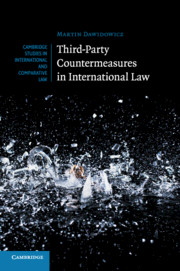Book contents
- Frontmatter
- Contents
- Foreword
- Preface
- Table of Cases
- List of Abbreviations
- 1 Introduction
- 2 Third-Party Countermeasures and the ICJ
- 3 Third-Party Countermeasures in the ILC
- 4 Third-Party Countermeasures in State Practice
- 5 Permissibility of Third-Party Countermeasures: Evaluation
- 6 Third-Party Countermeasures and Safeguards against Abuse
- Conclusion
- Bibliography
- Index
- Miscellaneous Endmatter
3 - Third-Party Countermeasures in the ILC
Published online by Cambridge University Press: 01 June 2017
- Frontmatter
- Contents
- Foreword
- Preface
- Table of Cases
- List of Abbreviations
- 1 Introduction
- 2 Third-Party Countermeasures and the ICJ
- 3 Third-Party Countermeasures in the ILC
- 4 Third-Party Countermeasures in State Practice
- 5 Permissibility of Third-Party Countermeasures: Evaluation
- 6 Third-Party Countermeasures and Safeguards against Abuse
- Conclusion
- Bibliography
- Index
- Miscellaneous Endmatter
Summary
This chapter will examine the contribution made by the ILC to the concept of third-party countermeasures in its lengthy work on the law of State responsibility. The ILC did not on first reading give serious attention to the question of third-party countermeasures and only considered it indirectly in the broader context of its effort to construct a multilateral public order. For decades, that construction remained a building site with essential works staying incomplete and resting on shaky foundations. It was only on second reading that the question of third-party countermeasures emerged as a discrete issue and was addressed squarely as part of a construction of a multilateral public order resting on more solid foundations. Thus, the building block of third-party countermeasures can only be properly understood as part of that broader construction. The relevant contribution made in this respect by the ILC on first reading (3.1) and on second reading (3.2) will be examined. This will be followed by some concluding observations (3.3).
The ILC's Contribution on First Reading (1963–1996)
The post-Charter era witnessed the emergence of several fundamental norms which transformed international law, including the principles of non-use of force and self-determination. In 1963, the ILC provisionally recognized the concept of peremptory norms in its work on the law of treaties – later adopted in 1969 as Articles 53, 64 and 71 of the VCLT. The question of the legal consequences of breaches of peremptory norms beyond the VCLT remained largely unexplored. The ILC (in the form of its Sub-Committee on State Responsibility, chaired by Ago) thus also decided in 1963 that, as part of its study of State responsibility, ‘careful attention should be paid to the possible repercussions which [these] new developments in international law may have had on responsibility’. As possible forms of responsibility, ‘reprisals’ and ‘collective sanctions’ would also be studied in this respect. The question of responsibility for the most serious violations of international law evidently merited particular attention. As a guide to the future work of the ILC, it was agreed that, in a first stage, the origin of responsibility should be examined, followed, in a second stage, by the forms or consequences of responsibility.
- Type
- Chapter
- Information
- Third-Party Countermeasures in International Law , pp. 72 - 110Publisher: Cambridge University PressPrint publication year: 2017

